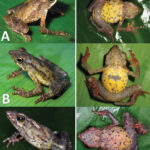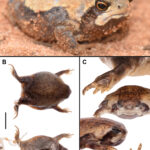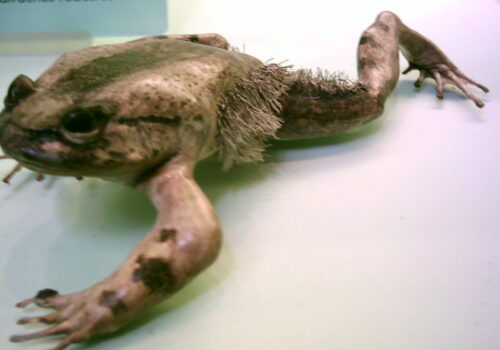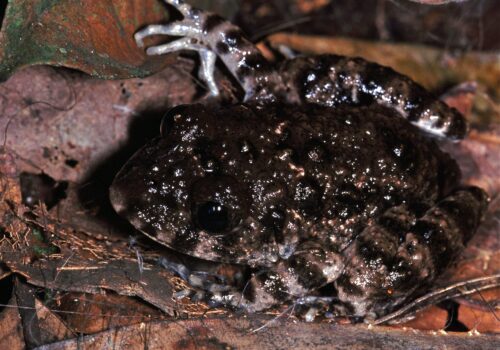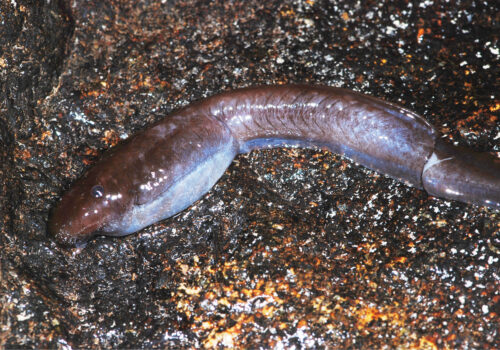- The Secretive World of Arthroleptis bivittatus: Discovering Africa’s Hidden Forest Frog
The Secretive World of Arthroleptis bivittatus: Discovering Africa’s Hidden Forest Frog#
Beneath the rich canopy of Africa’s tropical forests, veiled in shadow and resonant with nature’s symphony, lives a diminutive creature easily overlooked yet crucially important—the Arthroleptis bivittatus. Also known as the Two-striped Forest Frog, this enigmatic amphibian captivates scientists and nature enthusiasts alike, symbolizing the vibrant yet fragile intricacies of rainforest ecosystems. Classified scientifically as Arthroleptis bivittatus, this species embodies both the beauty and mystery of amphibian life, cloaked in behavior and abilities that astonish even seasoned biologists.
But what makes this modest frog worthy of deep exploration? Perhaps it is the subtle beauty etched into its delicate frame, or maybe the fascinating habits that set it apart from its amphibious brethren. Whatever the intrigue, Arthroleptis bivittatus deserves a closer look, carefully unveiling the biology, role, and challenges that shape its wild survival.
Taxonomy and Classification#
Belonging to the family Arthroleptidae—a diverse group commonly called squeaker frogs—Arthroleptis bivittatus occupies a distinct niche within amphibian taxonomy. First described scientifically in 1885 by Wilhelm Peters, the species epithet “bivittatus” originates from the Latin words “bi-” meaning two, and “vitta” meaning stripe, highlighting its distinctive striped appearance. Native and endemic primarily to regions in West and Central Africa, this frog represents a remarkable example of evolutionary adaptation to some of the planet’s most complex and lush habitats.
Within its genus, Arthroleptis constitutes a notable assemblage of species adapted uniquely to terrestrial life—divergent from the aquatic-dependent lifestyles of many amphibians. Close relatives such as Arthroleptis variabilis and Arthroleptis adelphus share environmental preferences and certain behavioral traits, yet it remains Arthroleptis bivittatus’s discreet charm and particular habitat adaptations that distinguish its special conservation importance.
Natural Habitat#
Arthroleptis bivittatus resides exclusively in forested regions, preferring humid, tropical, and subtropical lowland and montane forests. Its geographic range spans several Central and West African countries, notably Cameroon, Equatorial Guinea, Gabon, Central African Republic, the Republic of Congo, and the Democratic Republic of Congo. Throughout this extensive yet intermittently fragmented range, the species establishes hidden microhabitats within forest leaf litter, fallen logs, and moss-covered roots, rarely seen in the open.
The forest floor, shaded by towering trees and perpetually humid, creates a microclimate ideal for this frog’s cryptic lifestyle. Fallen leaves and decaying organic matter provide not only shelter but also an abundant supply of small invertebrate prey. The frog’s shy nature aligns with the dense ground cover supplied by ferns, mosses, and an assortment of understory vegetation, effectively camouflaging it from potential predators.
Navigating Life Amidst Leaf Litter#
The intricately layered forest floor offers more than just protection; it provides an ideal hunting ground. Here, moisture is retained even in dry seasons, offering Arthroleptis bivittatus survivability against harsh conditions that could otherwise threaten amphibious creatures dependent on standing water. The hidden realm beneath the mid-canopy—its microcosmic environment—is crucial for the survival of this species, providing not only shelter and sustenance but a safe zone for reproduction free from many disturbances found elsewhere.
Physical Characteristics#
The physical appearance of Arthroleptis bivittatus subtly reflects its unique ecological niche. Measuring typically between just 25 to 35 millimeters in length, adults are small, agile, and inconspicuous creatures, built perfectly for a life amidst leaf litter. Their coloration serves as a natural camouflage: shades of brown, tan, and grey align impeccably with decomposing leaves, twigs, and soil.
Most distinctively, Arthroleptis bivittatus sports two stripes that stretch longitudinally along the dorsum. These pale or creamy-toned bands contrast starkly with the earthy hues of their bodies, an evolutionarily refined color pattern providing enhanced camouflage against predators. Reflecting an adaptation perfected over countless generations, these stripes disrupt the frog’s outline when viewed from above, enhancing its protective coloration amidst forest detritus.
Functional Body Adaptations#
A closer examination reveals further specialized characteristics. Short, muscular hind limbs allow swift yet precise jumps, critical for capturing fast-moving invertebrates and dodging predators. Reduced webbing on small, delicate toes indicates limited aquatic interaction, aligning perfectly with the frog’s terrestrial existence. Large, sensitive eyes, slightly protruding, facilitate excellent night vision, assisting nocturnal hunting activities and threat recognition.
Behavior and Life Cycle#
The elusive nature of Arthroleptis bivittatus has posed significant observational challenges for herpetologists; still, dedicated field studies have gradually unraveled several aspects of its behavior and unique reproductive cycle. Observations typically occur during the rainy seasons when humidity peaks and activity levels heighten. During this period, distinct mating calls echo softly beneath dense vegetation, leading researchers directly to their concealed location.
Dietary Habits and Hunting Techniques#
Being predominantly nocturnal, Arthroleptis bivittatus emerges at dusk to engage in diligent hunts. It primarily preys upon small arthropods, including spiders, ants, termites, and beetles, expertly capturing such prey using its agile legs and swift leaps. An opportunistic feeder, the species employs stealth and patience, relying on its concealed position until prey comes into range, rapidly snapping with remarkable precision and speed. The forest provides abundant insect prey, particularly during periods of rainfall which stimulate insect emergence and activity.
Unique Reproductive Strategy#
Notably, Arthroleptis bivittatus, like other Arthroleptis species, practices direct development—a reproductive adaptation where eggs develop directly into miniature frogs, entirely bypassing the aquatic tadpole stage common among frogs. Females deposit their clutches in protected terrestrial sites, such as leaf litter, mosses, or beneath rotting logs. The egg’s encapsulated embryos nourish directly, eventually hatching as tiny, fully developed froglets that closely resemble their parents. This evolutionary adaptation profoundly benefits survival chances, reducing aquatic predation and drought vulnerability.
Ecological Role#
The role of Arthroleptis bivittatus in its habitat extends beyond simple predator-prey dynamics. Indeed, it serves as a crucial ecological sentinel species, indicating the health of forest ecosystems. High amphibian sensitivity to environmental disturbances such as drought, climate fluctuations, chemical pollutants, or habitat disruption makes this species’ presence or absence vitally informative.
Moreover, by controlling insect populations, Arthroleptis bivittatus and its close relatives maintain essential balance within lower trophic levels of forest ecosystems. This predator-prey interaction aids in limiting crop-damaging insects and disease vectors, indirectly benefiting agricultural communities adjacent to forest habitats.
Threats and Conservation Status#
Currently listed as Least Concern by the International Union for Conservation of Nature (IUCN), Arthroleptis bivittatus benefits from widespread distribution yet faces mounting pressures. Habitat fragmentation and deforestation rank among primary threats. Logging activities, agricultural expansion, palm oil plantations, and human-driven land transformations continually reduce suitable habitats, fragmenting populations and disrupting ecological interactions necessary for survival.
Climate Change Implications#
Climate change further exacerbates these threats, altering precipitation patterns, temperature regimes, and humidity cycles essential to this species. Reduced predictability in rainfall directly impacts prey availability and breeding success. Additionally, susceptibility to pathogens such as chytrid fungus—heightened under climate stress—potentially poses lethal risks, echoing global declines observed in amphibian populations worldwide.
Cultural and Scientific Significance#
While less prominently featured in traditional folklore compared to larger, more conspicuous species, Arthroleptis bivittatus holds intrinsic value in biodiversity preservation and scientific research. Its unique reproductive strategies and exquisite terrestrial adaptations signify evolutionary ingenuity applicable in broader ecological research and conservation biology.
Scientific studies examining responses to habitat fragmentation, climate change resilience, and pathogen susceptibility largely depend on such functionally unique, resilient yet sensitive species. Arthroleptis bivittatus thus contributes markedly to our understanding of anthropogenic impacts on forest-dependent organisms and informs broader conservation strategies for amphibian protection around the globe.
Conclusion: Celebrating and Protecting a Forest Ambassador#
Arthroleptis bivittatus exemplifies remarkable biological adaptation, cultural subtlety, and ecological importance. A testimony to the quiet complexities of forest life unseen by most, its conservation reminds us of our profound responsibility toward biodiversity stewardship. Protecting the hidden jungles housing this delicate yet tenacious creature also defends countless ecosystems services crucial for human and wildlife flourishing alike. Let us renew our dedication toward preserving the vibrant yet fragile worlds within which Arthroleptis bivittatus—and myriad other species—still thrive, despite the pressures of an ever-changing world.

